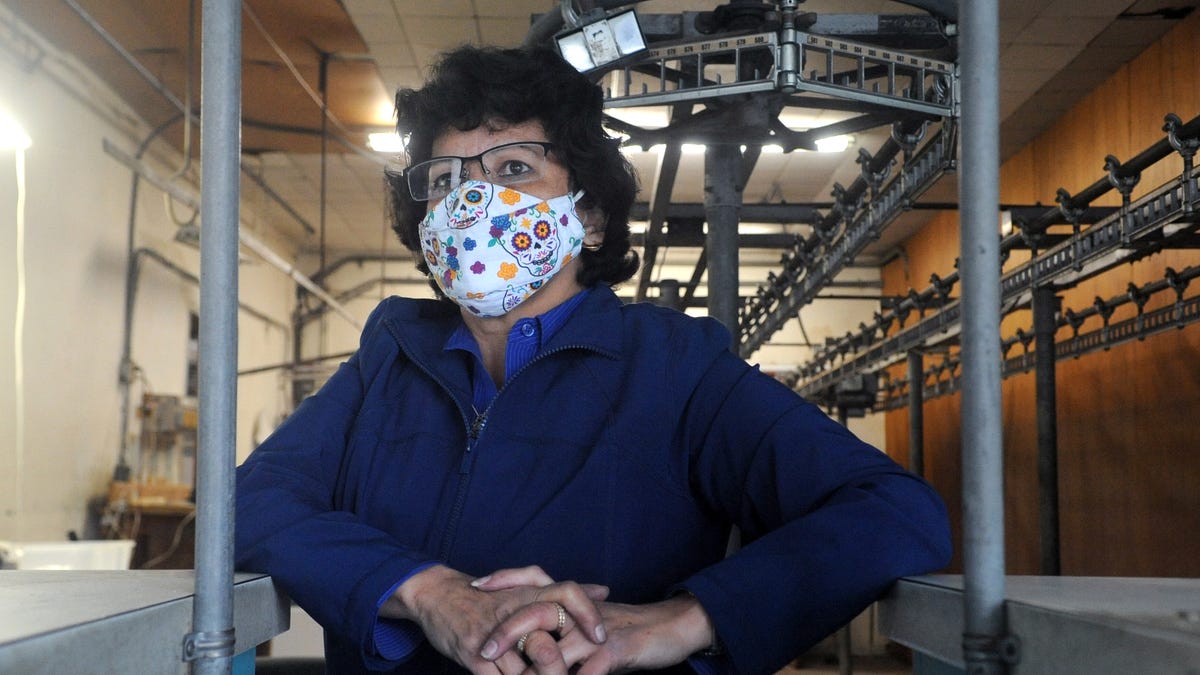LATEST FINANCIAL NEWS
‘It knocked me down’: Dry cleaners face devastation after COVID-19 stalled demand for work and formal attire
Nathan Bomey
| USA TODAYWhen the pandemic erupted, Theresa Sanchez’s dry-cleaning business in Austin, Texas, experienced a devastating drop in revenue.”It knocked me down like a hot potato,” she said.With virtually no business coming from hotels – one of her largest sources of income in pre-COVID-19 times — and her regular corporate customers working from home, there was little relief. She laid off most of her employees.Facing little hope of a return to office life as usual on the horizon, Sanchez recently decided to shut down her business, T’s Cleaners Twin Oaks, which was in a spot that had had a dry-cleaning business for six decades.Sanchez’s business is one of thousands of dry-cleaning operations that have already closed their doors permanently or are expected to go out of business in the coming months.Dry cleaners lost about 80% of their revenue immediately after the pandemic began, according to the Drycleaning & Laundry Institute, a trade association that represents the interests of several thousand members and provides training resources.As states have started to open up and some offices resume operations, dry cleaners have returned to anywhere from 40% to 60% of their pre-pandemic revenue, estimated Mary Scalco, the institute’s CEO.But things are especially bad “if you’re in a city where people aren’t traveling in to go to the office,” she said.Taxes and Social Security: Does your state tax social security benefits? Here’s why that’s crucial to your retirement strategy’The DNA of work has changed:Many want to keep working from home after COVIDCOVID-19 and work: 3 lasting changes employees could see at the officeHere are three big changes employees can expect as they go back to work after the COVID-19 pandemic.Staff Video, USA TODAYWhat happened to dry cleaners?Of the roughly 25,000 to 30,000 U.S. storefronts in the dry-cleaning industry, Scalco estimated that about 20% to 30% won’t survive because of the impact from the pandemic and expectations of fewer customers even after the crisis ends.Blame it on a sudden and sustained surge in remote work, the long-running decline of business attire, the temporary disappearance of formal events, and the yearlong collapse in business travel.Dry cleaners hit hard by labor force that is working from homePatricio Villarroel and Omaira Villarroel, owners of Pat the Tailor, a dry cleaner and tuxedo business, talk about being on the brink of closing after 37 years due to COVID-19.Tanya Breen, @tanyabreenphoto”Your typical person who dropped off something at the dry cleaner once a week – maybe they’re going there once a month now,” said Nick Shields, a retail analyst for research firm Third Bridge.Even for workers who need to look nice on camera during live-video meetings, there’s less need for dry cleaning.“With Zoom you will find that just like everybody else, you’re dressed from the waist up, and on the bottom, you’re in your PJs, so you don’t need professional care for that,” Scalco said.Pivoting to new laundry servicesTo be sure, many dry cleaners have pivoted since the pandemic began, bolstering their delivery operations – many of which were already in place – while investing in digital ordering and introducing new services, such as basic laundry.“Many people started doing what we call wash-dry-fold,” Scalco said. “Everybody’s at home and your workload is incredible. Let me do your laundry for you.”While some dry cleaners have managed to introduce new services before and during the pandemic, competition may limit their chances of diversifying, said Christopher Lombardo, an analyst for research firm IBISWorld who has studied the industry.“As consumers became increasingly concerned with visiting laundromats, many opted for remote full-service laundry services,” Lombardo said in an email. “Still, dry cleaners compete with traditional laundromats for this service, and many are unable to offer such services at a grand scale. Thus, the rise in demand is not expected to outweigh the detrimental conditions experienced.”Maria Kamperides, owner of four dry-cleaning storefronts in the Boston area operating under the brands Columbus Cleaners and Clothes Clinic, said her business has been sanitizing and cleaning uniforms for emergency responders since the pandemic began.But facing an immediate 90% drop in revenue at the start of the pandemic, she said her company, and likely other dry cleaners, would not have survived without emergency forgivable loans provided through the federal government’s Paycheck Protection Program and various state programs.“If it weren’t for the PPP loans and state grants and loans we had access to, I seriously doubt a lot of us would still be here,” she said. But “now we’re starting to see businesses close when they run out of the funds that they had access to.”Despite social distancing restrictions being gradually lifted as as the number of COVID-19 cases subsides, Kamperides said her business is still down 40% to 50% from its pre-pandemic revenue.Dry cleaning was already hurtingIt’s the latest blow for an industry that was already ailing amid the rise in business casual attire, which contributed to the 2020 bankruptcy filings of companies like the owner of Men’s Wearhouse and suits-seller Brooks Brothers.“Demand for industry services has been declining for years,” Lombardo said.Making matters for worse for mom-and-pop shops is that large operators like Tide, the laundry brand owned by Procter & Gamble, have begun opening branded stores or consolidating locations in recent years. Tide now has hundreds of dry-cleaning operations throughout the country.In many cases, major corporate dry-cleaning operations are setting up storefronts without on-site cleaning equipment and then outsourcing the actual dry cleaning to mom-and-pop shops at rock-bottom prices, Kamperides said.“This will disrupt our industry” further, she said.Will people tire of remote work?As the pandemic continues to ease, dry cleaners are hoping that remote work similarly subsides.But for now, 32% of adults are still working from home full-time, while another 21% head to the office only sometimes, according to a Harris Poll survey of 2,063 adults conducted May 14-16 and provided exclusively to USA TODAY.The rest are either back in the office after previously working from home (19%) or never worked from home to begin with (27%).“Moving forward, the public returning to work and the office is expected to help moderately,” Lombardo said. “However, work attire is expected to continue to trend in the direction of less formal clothing, resulting in declining demand for dry clean services.”Kamperides, for one, is hoping that people are getting sick of working from home.“I’m getting the sense from speaking to customers and friends who have corporate jobs that they’re kind of hoping that they do go back to work, at least part of the week, or hybrid mode,” she said. “I don’t think people are enjoying their work-from-home isolation as much as they did at the beginning of the pandemic.”Formal events may rise as COVID-19 fallsOne reason for hope is that formal events are picking up. This year is expected to be a banner summer for weddings, many of which were delayed in 2020 due to gathering restrictions.That means a lot of wine spills and food stains that will need to be cleaned.“We’ll see a surge of weddings and events that are happening, but I don’t know if they’ll be spending like they used to,” Kamperides said.Some dry cleaning business owners are ready to move on.Sanchez, the Austin entrepreneur who closed her dry-cleaning business, said she’s planning to get a part-time job. She said she wanted to show her daughter how to work through setbacks.”I need to show her that even with changes, life goes on,” she said. “She needs to see that. Don’t give up.”Contributing: Katie Kull and Austin Huguelet of the Springfield News-Leader; the Austin American-StatesmanYou can follow USA TODAY reporter Nathan Bomey on Twitter @NathanBomey and subscribe to our free Daily Money newsletter here for personal finance tips and business news every Monday through Friday morning.
Source link









